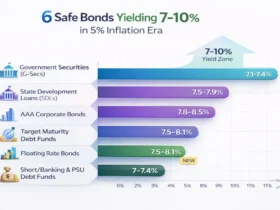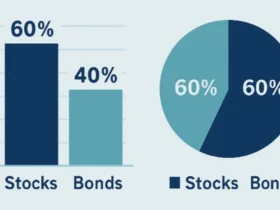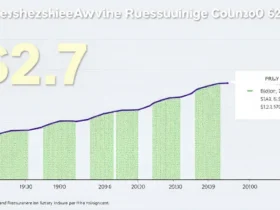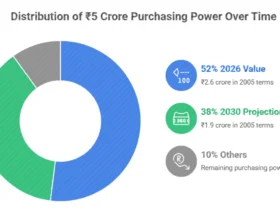Introduction: A Dream Worth Chasing
You invest ₹50,000 today, and in just 5 years, it transforms into ₹10 lakhs. Sounds like a fantasy, right? But what if I told you it’s not entirely out of reach? I’ve seen people start with small sums and build life-changing wealth with the right moves. Take my friend Arjun—he began with a modest amount, and through smart investing, he’s now sitting on a fortune. It’s not magic; it’s strategy, patience, and a little know-how.
Table of Contents
In this guide, I’m going to walk you through how this bold goal might be possible. Whether you’re new to investing or looking to level up, you’ll discover practical steps, real-world insights, and expert advice to grow your money. Stick with me, and by the end, you’ll know exactly how to turn your ₹50,000 into something extraordinary. Ready to make your money work harder? Let’s dive in!
The Power of Compound Interest: Your Wealth-Building Superpower
What Is Compound Interest?
Ever heard the saying, “Money makes money”? That’s compound interest in a nutshell. It’s when your earnings generate more earnings, creating a snowball effect. Picture this: you invest ₹50,000, earn returns, and then those returns earn returns. Over time, it’s like planting a tiny seed that grows into a massive tree.
Why It Matters for Your ₹50,000
To see how powerful this is, let’s break it down. If you invest ₹50,000 today, here’s how it could grow at different annual rates over 5 years:
| Year | 10% Return | 15% Return | 20% Return |
|---|---|---|---|
| 1 | ₹55,000 | ₹57,500 | ₹60,000 |
| 2 | ₹60,500 | ₹66,125 | ₹72,000 |
| 3 | ₹66,550 | ₹76,043 | ₹86,400 |
| 4 | ₹73,205 | ₹87,450 | ₹103,680 |
| 5 | ₹80,525 | ₹100,567 | ₹124,416 |
At 20% annual growth, your ₹50,000 doubles to ₹124,416 in 5 years. Impressive, but still a long way from ₹10 lakhs. So, how do we get there? Keep reading—we’re just getting started.
Key Takeaway: Compound interest is your best friend, but to hit ₹10 lakhs, we’ll need more than a one-time investment at typical rates.
Can a One-Time ₹50,000 Investment Reach ₹10 Lakhs?
The Math Behind the Magic

Let’s crunch the numbers. To grow ₹50,000 into ₹10 lakhs in 5 years with a single investment, you’d need a jaw-dropping annual return. Here’s the formula:
[
\text{Future Value} = \text{Present Value} \times (1 + r)^n
]
- Present Value: ₹50,000
- Future Value: ₹10,00,000
- n: 5 years
Plugging it in:
[
10,00,000 = 50,000 \times (1 + r)^5
(1 + r)^5 = 20
1 + r = 20^{1/5} \approx 1.82
r \approx 82\%
]
You’d need an 82% annual return. That’s not impossible, but it’s rare and risky. Think high-growth stocks, venture capital, or even cryptocurrency during a boom. But here’s the catch: these come with huge risks, and there’s no guarantee.
High-Risk Options to Consider
- Stocks: Some small-cap stocks have delivered massive returns (think 50-100% yearly in bull markets), but they can crash just as fast.
- Startups: Investing in a promising startup could yield exponential gains if it takes off.
- Crypto: Bitcoin grew over 100% some years, but it’s a rollercoaster.
Expert Quote: “The stock market is a device for transferring money from the impatient to the patient.” – Warren Buffett
Reality Check
For most of us, banking on an 82% return isn’t practical. It’s like betting your life savings on a single horse. So, if a one-time shot won’t cut it, what will? Let’s explore a smarter approach.
The Game-Changer: Regular Investments with SIPs
What’s an SIP?
A Systematic Investment Plan (SIP) is like a financial fitness plan. You invest a fixed amount regularly—say, monthly—and let compounding and market growth do the heavy lifting. It’s perfect for beginners because it reduces risk and builds discipline.
How It Could Work for You
Let’s say you start with ₹50,000 and add ₹10,000 monthly for 5 years at a 15% annual return. Here’s the breakdown:
- Initial Investment: ₹50,000
- Monthly SIP: ₹10,000
- Total Invested: ₹50,000 + (₹10,000 × 60) = ₹6,50,000
- Future Value: Around ₹9,50,000 (using an SIP calculator)
Not quite ₹10 lakhs, but close! To hit the mark, you could:
- Increase your SIP: Bump it to ₹12,000 monthly.
- Aim higher: Seek funds with 18-20% returns (more on this later).
Here’s a quick table for different SIP amounts at 15%:
| Monthly SIP | Total Invested | Value in 5 Years |
|---|---|---|
| ₹10,000 | ₹6,50,000 | ₹9,50,000 |
| ₹12,000 | ₹7,70,000 | ₹11,30,000 |
| ₹15,000 | ₹9,50,000 | ₹14,00,000 |
Pro Tip: Start small, stay consistent, and increase your SIP as your income grows.
Choosing the Right Investment Vehicles
Mutual Funds: The Beginner’s Goldmine
Mutual funds pool money from many investors to buy stocks, bonds, or other assets. They’re managed by experts, making them ideal if you’re busy or new to investing.
- Equity Funds: High risk, high reward (12-20% average returns).
- Debt Funds: Safer, but lower returns (6-8%).
- Hybrid Funds: A balanced mix for moderate growth.
Stocks: The DIY Route
Love a challenge? Pick individual stocks. Some Indian small-cap stocks have returned 30-50% annually during growth phases. But you’ll need research and nerves of steel.
Fixed Deposits: Safe but Slow
FDs offer 5-7% returns—great for security, but they won’t get you to ₹10 lakhs fast. Use them for emergency funds, not wealth-building.

Real Estate: Big Wins, Big Commitment
Invest ₹50,000 as a down payment on a property that doubles in value. Possible? Yes, in booming areas. Practical? Not for everyone—it’s illiquid and management-heavy.
Expert Quote: “Risk comes from not knowing what you’re doing.” – Warren Buffett
Managing Risks: Don’t Lose What You Build
Diversify Like a Pro
Never put all your eggs in one basket. Spread your ₹50,000 (and future investments) across:
- Stocks and mutual funds for growth.
- FDs or bonds for stability.
Monitor and Adjust
Check your investments quarterly. If a fund’s underperforming, switch to a better one. Apps like Groww or Zerodha make this easy.
Set Realistic Expectations
An 82% return is a long shot. Aim for 15-20% with equity funds—still ambitious but doable. Accept that losses can happen, and plan accordingly.
Real-Life Success: Arjun’s Story
Meet Arjun, a 32-year-old from Mumbai. In 2018, he invested ₹50,000 in a mix of equity mutual funds. He also started a ₹5,000 monthly SIP. His picks? Aggressive small-cap and mid-cap funds averaging 18% returns.
By 2023, his portfolio hit ₹3,50,000. Not ₹10 lakhs, but a 7x growth from his initial sum! How?
- Consistency: He never missed an SIP.
- Patience: He rode out market dips.
- Research: He chose funds with proven track records.
Arjun’s lesson? Start small, add regularly, and trust the process. Your ₹10 lakhs might take a bit longer, but the journey’s worth it.
Expert Tips to Supercharge Your Journey
Start Early
“The best time to plant a tree was 20 years ago. The second-best time is now.” – Chinese Proverb. Every month you wait costs you compounding power.
Educate Yourself
Read books like Rich Dad Poor Dad or follow financial blogs. Knowledge reduces risk and boosts confidence.
Consult a Pro
A certified financial planner can tailor a plan to your goals. It’s like hiring a coach for your money.
Conclusion: Your ₹10 Lakh Dream Starts Today
So, can ₹50,000 invested today become ₹10 lakhs in 5 years? With a one-time shot, it’s a stretch—requiring an 82% return that’s tough to guarantee. But with regular investments, like an SIP, and a solid 15-20% return, you’re on track to build serious wealth. Arjun’s story proves it: small steps, big results.
Your money’s sitting there, waiting to grow. Don’t let it idle—start your SIP today, pick a smart fund, and watch your future self thank you. Ready to turn your ₹50,000 into a fortune? The first step is yours to take!
FAQ: Your Questions Answered
1. Is it really possible to turn ₹50,000 into ₹10 lakhs in 5 years?
With a one-time investment, it’s unlikely without massive risk (82% annual return). But with regular SIPs and 15-20% returns, you can get close or exceed it.
2. What’s the safest way to invest ₹50,000?
Fixed deposits or debt funds are low-risk but won’t hit ₹10 lakhs fast. Equity mutual funds with diversification are safer for growth.
3. How much should I invest monthly to reach ₹10 lakhs?
At 15% returns, an SIP of ₹12,000 monthly (plus ₹50,000 initially) gets you there in 5 years.
4. What are the risks involved?
Equity investments can dip with market crashes. Diversify and invest long-term to manage risks.
5. How do I get started?
Open an account with apps like Groww, pick a mutual fund, and start your SIP. It takes 10 minutes!
6. Can I do this without a financial advisor?
Yes, with research! But an advisor can optimize your plan if you’re unsure.




























Leave a Reply